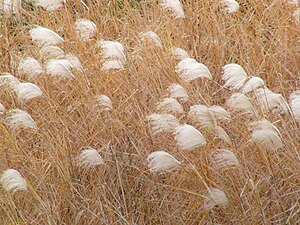Miscanthus sacchariflorus
| Miscanthus sacchariflorus | ||||||||||||
|---|---|---|---|---|---|---|---|---|---|---|---|---|

Miscanthus sacchariflorus |
||||||||||||
| Systematics | ||||||||||||
|
||||||||||||
| Scientific name | ||||||||||||
| Miscanthus sacchariflorus | ||||||||||||
| ( Maxim. ) Hack. |
Miscanthus sacchariflorus is a species of grass from the sweet grass family(Poaceae). The plant native to East Asia is one of the parent species of the giant Chinese reed ( Miscanthus × giganteus ) as an energy plant.
features
Miscanthus sacchariflorus is a perennial plant and forms long, slender rhizomes that are covered with short, bald to hairy cataphylls . The stalks are slender, upright, 65 to 160 cm high, not hollow and unbranched. The leaves are on the stalk. The leaf sheaths are grooved and glabrous. The leaf blades are linear, flat, 20 to 50 cm long and 0.5 to 1.5 cm wide. They are bald, have a distinct midrib and taper to a point. The ligule is around 5 mm long and has eyelashes 1 to 2 mm long.
The inflorescence is a 7 to 30 cm long panicle , the main axis of which is 5 to 15 cm long, glabrous or hairy at the base. The four to 24 racemose partial inflorescences are 5 to 20 cm long. The internodes of the rachis are bare, the nodes bare or hairy. The spikelets are 4 to 6 mm long, hairy and not awned. 8 to 12 mm long hairs that protrude from the spikelet sit on the callus. The glumes are heterogeneous, membranous, 4 to 6 mm long, with indistinct nerves and pointed at the end. The lower glume is hairy with long hairs on the edges. The upper one has only short hairs at the tip. The lemmas are lanceolate, hyaline and around 3 mm long. They have 0 to 1 nerves, the tip and edges are hairy. The palea is formed as a small, nerveless, hairy scale. The three anthers are 2 to 2.5 mm long. The caryopsis is elongated.
The number of chromosomes is 2n = 40.
Distribution and locations
Miscanthus sacchariflorus occurs in China (Gansu, Hebei, Henan, Shaanxi), in Japan, Korea and in eastern Russia. It grows on mountain slopes and on river banks.
literature
- Chen Shouliang, Stephen A. Renvoize: Miscanthus Andersson, Öfvers. Kongl. Vetensk.-Akad. Förh. 12: 165, 1855 , Flora of China, Vol. 22, 2006, pp. 581-583. ( Online ; PDF; 192 kB)